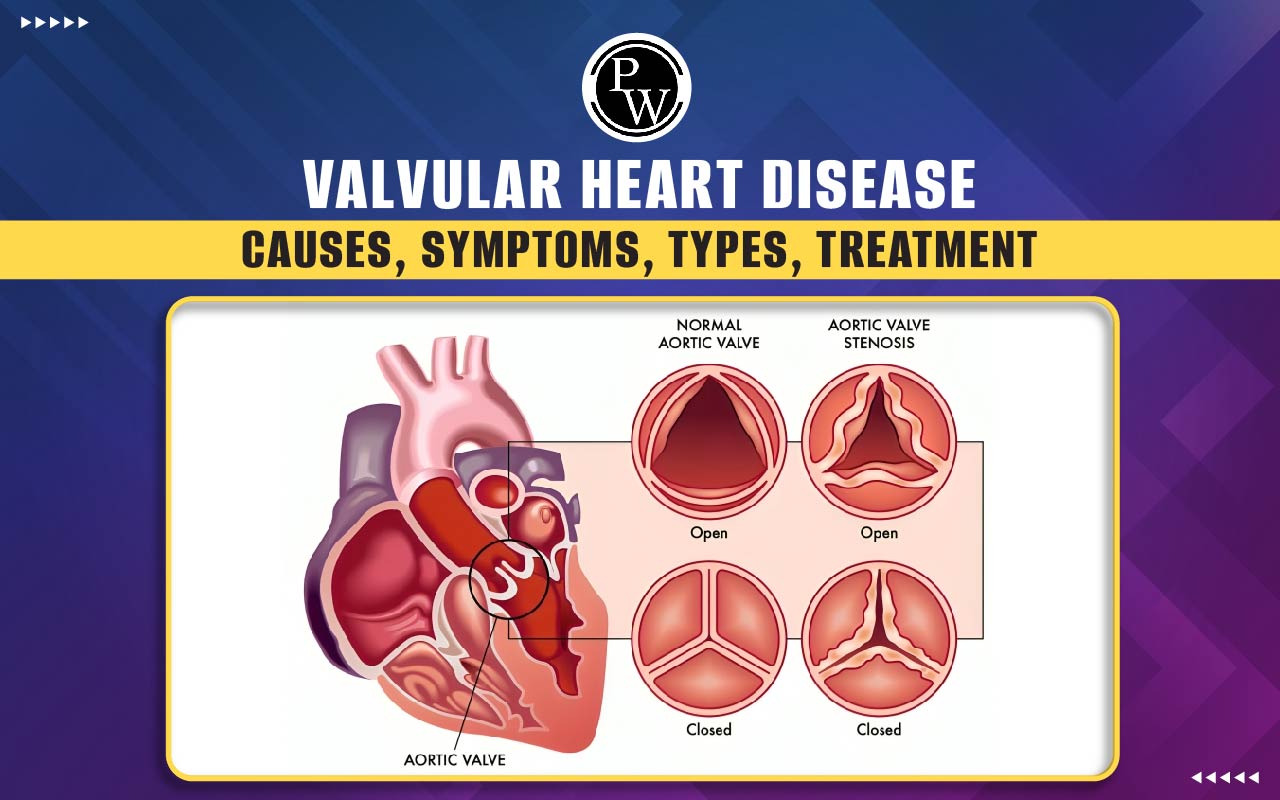

Valvular Heart Disease occurs when the valves in your heart, responsible for ensuring blood flow properly, don't function correctly. While medications can assist with blood flow issues, sometimes they're insufficient. Your doctor will determine if you require valve repair or replacement.
Treatment for Valvular Heart Disease depends on which valve is affected and how severe the problem is. Surgery might be necessary to fix or replace the faulty valve. This article provides information on the symptoms, diagnosis, treatments, and causes of Valvular Heart Disease, which is helpful for candidates seeking a career in medicine.Valvular Heart Disease Overview
Valvular Heart Disease is when the valves in your heart don't work right. Without treatment, your heart can work harder and become dangerous. However, some surgeries or other procedures can fix or replace the faulty valves, helping your heart work typically again. Further details about the disease are mentioned below:- The human heart has four valves: the mitral, tricuspid, aortic, and pulmonary.
- These valves ensure that blood flows in one direction through your heart.
- Oxygen-poor blood enters the right side of your heart and goes through the tricuspid and pulmonary valves to get oxygen from your lungs.
- The oxygen-rich blood returns to the left side of your heart and passes through the mitral and aortic valves to be pumped to the rest of your body.
- The valves have leaflets that open and close to control blood flow, with the mitral valve having two leaflets and the others having three.
- Papillary muscles help stabilize the valve leaflets to prevent backward blood flow.
Types of Valvular Heart Disease
Valvular Heart Disease can come in various types, and more than one valve in your heart can be affected. The multiple kinds of Valvular Heart Diseases are listed below in the table:| Types of Valvular Heart Disease | |
| Name of Valvular Heart Disease | Details |
| Valvular stenosis | Valvular stenosis occurs when the valve leaflets stiffen, reducing the valve opening and blood flow. Severe narrowing strains the heart, requiring it to work harder to pump blood, leading to inadequate blood flow to the body. |
| Valvular insufficiency | Valvular insufficiency, or "leaky valve," occurs when heart valves don't close properly, causing blood to flow backwards. This strains the heart and may decrease blood flow to the body. |
| Valvular atresia | Valvular atresia occurs when a heart valve doesn't develop properly before birth and is often diagnosed in infancy. |
Valvular Heart Disease Symptoms
Many people with Valvular Heart Disease don't show symptoms initially. However, as the condition worsens, the heart works harder to compensate for reduced blood flow, leading to symptoms such as- Breathing difficulties, particularly during exercise or when lying down.
- Irregular heartbeat sensations.
- Swelling in the ankles, feet, or abdomen.
- Weakness or dizziness.
- Rapid weight gain.
- Chest discomfort, especially during physical activity.
- Fatigue.
- If the valve problem is due to an infection, you might also have a fever, chills, or body pains.
Valvular Heart Disease Causes
There are several causes of Valvular Heart Disease, including infections, Degenerative conditions, and conditions linked to another type of heart disease. The other causes of Valvular Heart Disease include the following:- Untreated strep throat leading to rheumatic fever.
- Damage to the heart from a heart attack.
- Advanced high blood pressure.
- Birth defects affecting valve development.
- Degeneration or hardening of valve tissue over time.
- Enlargement of the aorta, stretching valve leaflets.
- Heart failure.
- Heart infections (endocarditis).
Valvular Heart Disease Diagnosis
During a checkup, your healthcare provider may detect signs of Valvular Heart Disease by:- When using a stethoscope to listen to your heart, you may hear abnormal sounds like crackles, which could indicate fluid in your lungs, or murmurs, which may suggest an enlarged heart.
- Identifying a heart murmur indicates blood flow issues through a narrow or leaky valve.
- You are noting swelling in your ankles, a sign of possible heart valve problems.
Tests Done for Diagnosis of Valvular Heart Disease:
The various tests done for diagnosis of Valvular Heart Disease include the following:- Echocardiogram: Ultrasound for heart images.
- Transesophageal echocardiogram (TEE): Clearer images via probe down the esophagus.
- Exercise stress echocardiogram: Assesses heart function during activity.
- Chest X-ray: Quick chest scan for abnormalities.
- Cardiac catheterization (angiogram): X-ray movies with contrast dye injection.
- Electrocardiogram (EKG or ECG): Records heart's electrical activity.
- Magnetic resonance imaging (MRI): Produces detailed heart images with radio waves and magnets.
Management and Treatment of Valvular Heart Disease
A heart valve issue can be severe if left untreated. While you can't reverse damage to a heart valve, you can manage the problem. Treatment for Valvular Heart Disease depends on the cause and may involve:- Preventing further damage to the valve.
- Taking prescribed medications.
- Valvular Heart Disease may need surgery to fix or replace the valve. Surgeons decide during surgery if repair or replacement is best. Minimally invasive options are available depending on your condition.
- Regularly visit your cardiologist for check-ups.
Valvular Heart Disease Medications
While medications cannot cure Valvular Heart Disease, they play a crucial role in managing symptoms and reducing the risk of complications such as stroke or cardiac arrest. Following valve surgery, ongoing medication may be necessary to prevent arrhythmias blood clots, or manage conditions like high blood pressure or heart failure. Valvular Heart Disease is a condition you'll have for life, but with the proper treatment from your healthcare provider, you can manage it well. Whether it's medication or surgery, your provider will discuss the best plan for you. You can also help by staying active, eating healthy, avoiding tobacco, taking your prescribed medicines, and attending your follow-up appointments regularly. If you aim for comprehensive knowledge on Valvular Heart Disease and other medical topics essential for NEET PG, FMGE, or INICET exams, take action now! Download the PW MedEd app and gain access to top-tier video lectures, live sessions, and high-quality study materials crafted to enhance your preparation.Valvular Heart Disease FAQs
What causes the Heart valve to go wrong?
Age is the primary reason why the heart valve situation is getting worse.
What is the most common valve to be repaired?
The mitral valve is the most common valve to be repaired.
What is the lifespan of the heart valve?
Mechanical valves usually last 20 years or more.
Can you live an everyday life with Valvular Heart Disease?
Most heart valve disorders are treated safely, leading to a normal lifestyle.
Talk to a counsellorHave doubts? Our support team will be happy to assist you!

Check out these Related Articles
Free Learning Resources
PW Books
Notes (Class 10-12)
PW Study Materials
Notes (Class 6-9)
Ncert Solutions
Govt Exams
Class 6th to 12th Online Courses
Govt Job Exams Courses
UPSC Coaching
Defence Exam Coaching
Gate Exam Coaching
Other Exams
Know about Physics Wallah
Physics Wallah is an Indian edtech platform that provides accessible & comprehensive learning experiences to students from Class 6th to postgraduate level. We also provide extensive NCERT solutions, sample paper, NEET, JEE Mains, BITSAT previous year papers & more such resources to students. Physics Wallah also caters to over 3.5 million registered students and over 78 lakh+ Youtube subscribers with 4.8 rating on its app.
We Stand Out because
We provide students with intensive courses with India’s qualified & experienced faculties & mentors. PW strives to make the learning experience comprehensive and accessible for students of all sections of society. We believe in empowering every single student who couldn't dream of a good career in engineering and medical field earlier.
Our Key Focus Areas
Physics Wallah's main focus is to make the learning experience as economical as possible for all students. With our affordable courses like Lakshya, Udaan and Arjuna and many others, we have been able to provide a platform for lakhs of aspirants. From providing Chemistry, Maths, Physics formula to giving e-books of eminent authors like RD Sharma, RS Aggarwal and Lakhmir Singh, PW focuses on every single student's need for preparation.
What Makes Us Different
Physics Wallah strives to develop a comprehensive pedagogical structure for students, where they get a state-of-the-art learning experience with study material and resources. Apart from catering students preparing for JEE Mains and NEET, PW also provides study material for each state board like Uttar Pradesh, Bihar, and others
Copyright © 2025 Physicswallah Limited All rights reserved.
Get App











